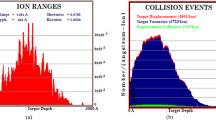Abstract
Experimental evidence is presented that high-temperature annealing of Zn-containing SiO2 films on Si gives rise to phase separation, accompanied by the formation of Zn-enriched bands. Appreciable amounts of zinc (sufficient to change the conductivity type of Si and to raise its resistivity) diffuse to only small depths (≤10 μm) and at relatively short diffusion times. Long-term high-temperature annealing reduces the Zn concentration in the film. This process can be inhibited by applying a protective SiO2 layer.
Similar content being viewed by others
REFERENCES
Kornilov, B.V. and Lugakov, P.F., Recombination in Zinc-Doped Silicon, Fiz. Tekh. Poluprovodn. (Leningrad), 1972, vol. 8, no. 9, pp. 1790-1795.
Lebedev, A.A., Deep Level in Silicon and Gallium Arsenide, Doctoral (Phys.-Math.) Dissertation, Leningrad: Ioffe Physicotech. Inst., 1984.
Komarovskikh, K.F., Low-Resistivity Silicon Compensated by Deep Zinc Centers, Fiz. Tekh. Poluprovodn. (Leningrad), 1985, vol. 19, no. 1, pp. 349-354.
Perett, M., Stolwijk, N.A., and Cohausz, L., Kick-Out Diffusion of Zinc in Silicon at 1262 K, J. Phys.: Condens. Matter, 1989, vol. 1, pp. 6347-6361.
Borisenko, A.I., Troshina, E.P., Chepik, L.F., et al., Determination of Zinc in Film-Forming Solutions and Films by Emission Laser Microanalysis, Vopr. Radioelektron., Ser. TPO, 1986, no. 1, pp. 118-122.
Prikhod'ko, N.E., Borisenko, A.I., and Chepik, L.F., Preparation of Glassy Coatings via Application of Film-Forming Solutions to Silicon Wafers, Vopr. Radioelektron., Ser. TPO, 1970, no. 1, pp. 20-26.
Bykovskii, Yu.A., Timoshin, V.T., Laptev, I.D., and Manykin, E.A., Correlation between the Binding Energy of Neutrons in Nuclei and the Anomalous Isotope Fractionation in Medicobiologic Entities, Fizika, 1986, no. 10, pp. 62-66.
Boltaks, B.I., Dzhafarov, T.D., and Usov, O.N., Effect of the Decomposition of Solid Solution of Gold in Silicon on the Infrared Vibrational Spectrum of Oxygen, Fiz. Tverd. Tela (Leningrad), 1969, vol. 11, no. 4, pp. 889-891.
Kung, C.Y., Effect of Thermal History on Oxygen Precipitates in Czochralski Silicon Annealed at 1050?C, J. Appl. Phys., 1989, vol. 62, no. 12, pp. 4654-4665.
Infrakrasnye spektry neorganicheskikh stekol i kristallov (Infrared Spectra of Inorganic Glasses and Crystals), Vlasov, A.G. and Florinskaya, V.A., Eds., Leningrad: Khimiya, 1972, p. 138.
Author information
Authors and Affiliations
Rights and permissions
About this article
Cite this article
Voronkova, G.M., Zuev, A.V., Zuev, V.V. et al. High-Temperature Zinc Doping of Silicon from Zinc-Containing SiO2 Films. Inorganic Materials 39, 904–910 (2003). https://doi.org/10.1023/A:1025540818101
Issue Date:
DOI: https://doi.org/10.1023/A:1025540818101




